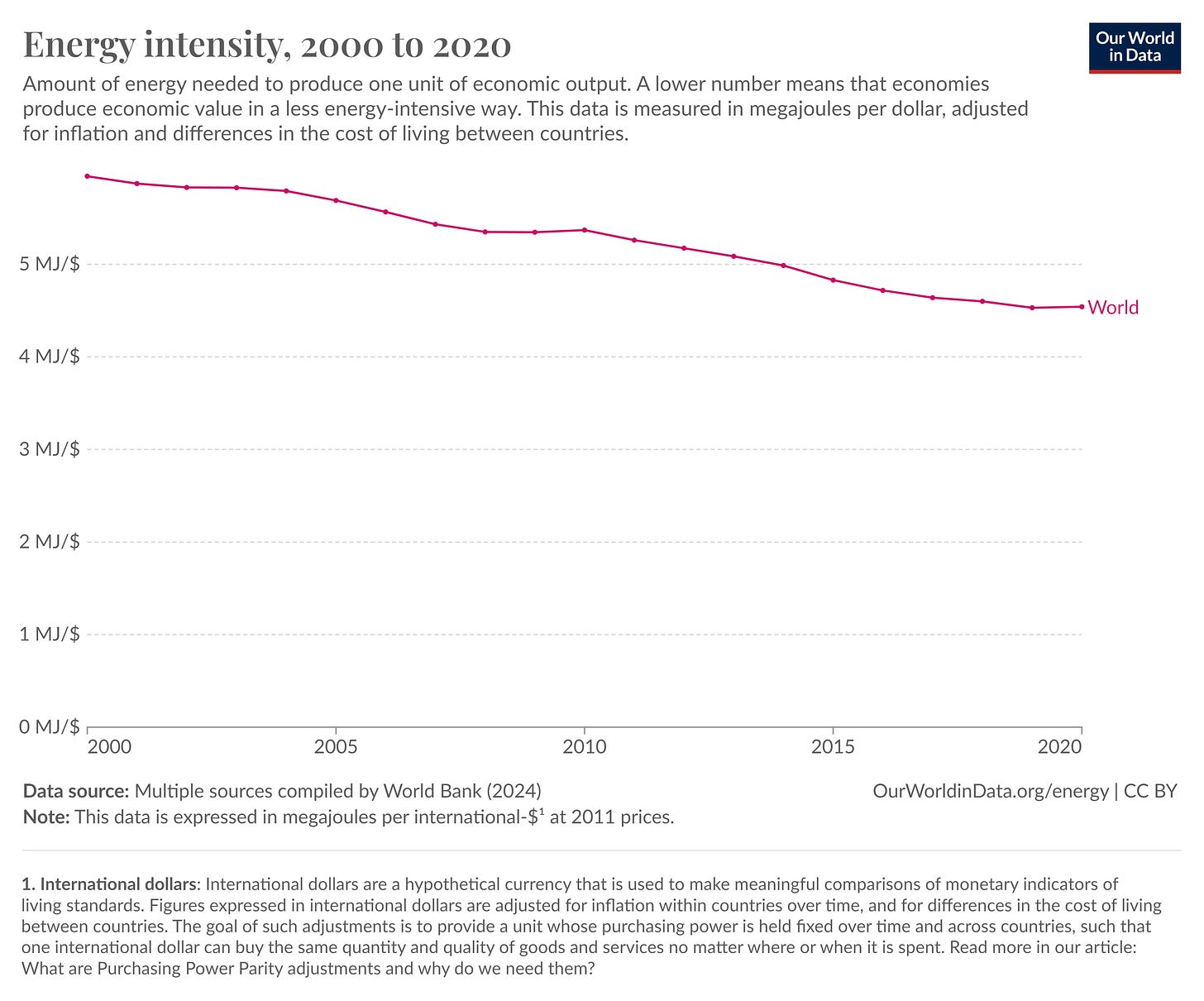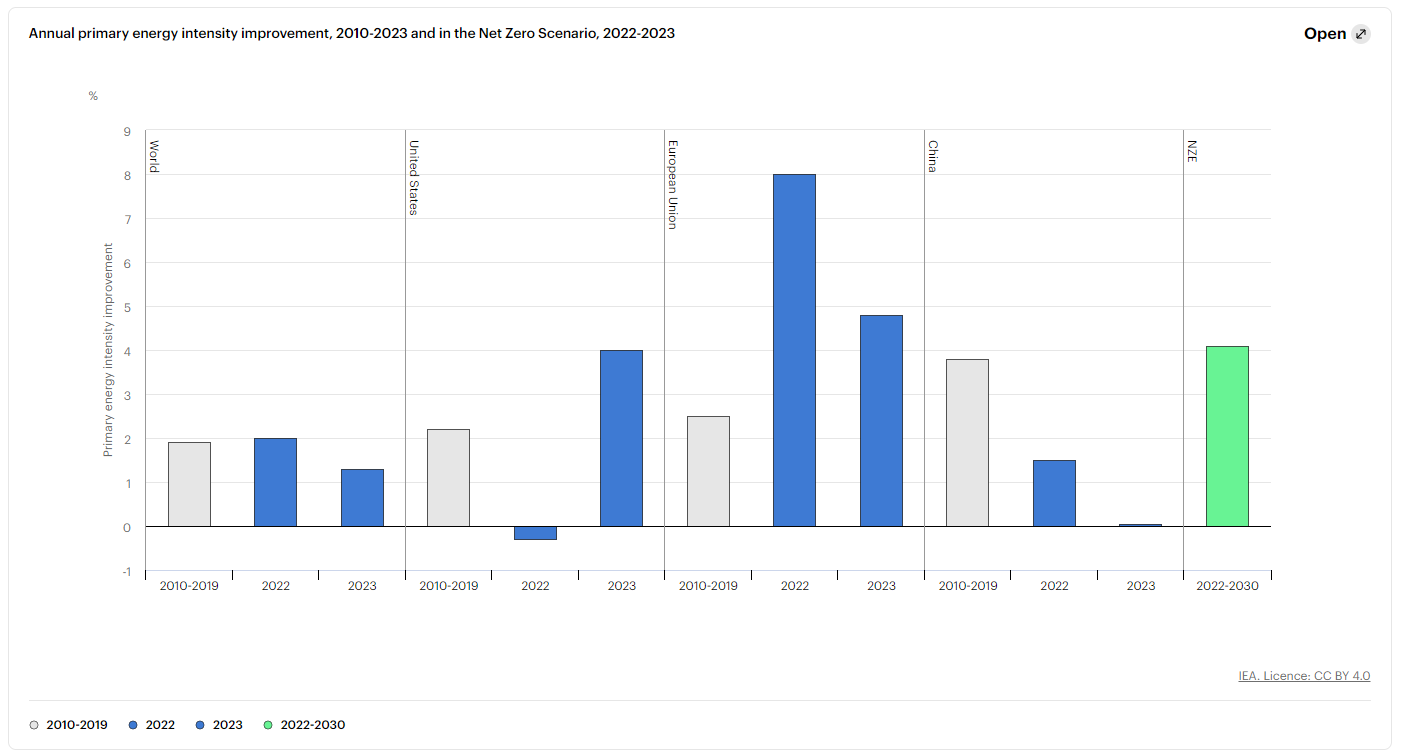Transforming our energy system is the most fundamental challenge on our way to a carbon-neutral world, yet many people’s energy knowledge seems to be superficial at best.
Time to change that!
In this week’s edition of Terreminder, we will have a look at the concept of energy intensity - one of the most relevant metrics in climate economics.
It’s going to be - forgive me - intense!
Definition of energy intensity
Energy intensity refers to the energy needed to produce an additional dollar of economic output. In other words: It is the energy used to deliver one more unit of GDP.1
Why does it matter? Because reducing energy intensity contributes to decoupling economic growth from energy use and emissions. This is crucial for achieving our climate goals.
The lower an economy’s energy intensity, the more the return on each unit of energy used. Economic growth leads almost always to higher energy use, but at the same time, to declining energy intensity (mostly). A lower energy intensity is usually a proxy for efficiency improvements.2
For example, in the US, intensity has fallen about 2% annually since 1974. During that period, energy consumption grew by a third. That growth would have been much higher without the declining energy intensity.3 Globally, energy intensity has improved by an average of 1.7 % over the last decades. It is projected to improve even more over the next thirty years.4
The EU’s energy intensity is now 42% lower than the global average, while Russia’s energy intensity is 92% higher than the global average.5
Energy intensity vs. other concepts
Let us briefly look at three other important energy concepts that are often being confused with energy intensity:
Energy Use Intensity: EUI measures how much energy a building uses for each unit of floor space.
Energy Efficiency: Energy efficiency means using less energy to do the same job or get the same result.
Energy Productivity: Energy productivity shows how much economic value (like GDP) is created for each unit of energy used.
Which factors influence energy intensity?
Technological Advancement: More efficient technology generally reduces energy intensity. No shit, Sherlock.
Industrial structure: Economies with heavy reliance on energy-intensive industries such as manufacturing, steel production, and mining, typically have higher energy intensity. In contrast, economies that are more digital and service-based tend to be less energy-intensive.
Level of Development: Developing countries often have a higher energy intensity because they are in the phase of building heavy industries and infrastructure. Energy intensity is usually lower in developed countries. In these countries, less energy-intensive sectors such as technology and services play a bigger role.
Policies: Well-designed policies and regulations that promote efficiency can reduce energy intensity. Examples include strict efficiency standards, targeted subsidies for clean tech, and penalties for wasteful energy use.
Energy Mix: Countries with a higher share of renewables tend to have lower energy intensity. Fossile fuels, especially coal and oil, are much less efficient.
Climate and Geography: Energy intensity is usually higher in places with large temperature variations. These regions require more heating and cooling. Larger distances also tend to increase energy intensity.
Consumer Behavior: Consumer behavior can significantly influence energy intensity by affecting the amount of energy used. If more people choose energy-efficient appliances, reduce car usage, or switch to renewable energy sources, overall energy demand can decrease, leading to lower energy intensity.
Limits: Not everything is about efficiency!
Efficiency gains are not necessarily the only reason for a decline in energy intensity. Structural changes in the economy, such as the shift from energy-intensive industries (like manufacturing) to less energy-intensive sectors (like services or technology), can also reduce energy intensity. So can a simple decline in energy demand: Weak industrial activity often causes a decline in energy intensity, even though there has not been a change in efficiency.6
Outlook: A better future is less intense
While global energy intensity has been declining for decades, the true challenge, the final boss of the energy transition, is to reduce absolute energy use.7 Despite remarkable progress in terms of energy productivity and energy intensity, energy use increased by 50% between 1990 and 2015.8
Energy intensity improves as economies mature. At some point (the sooner the better) this must translate into absolute cuts in energy use.9 To achieve this, we need to decouple economic growth from energy use: Our economies need to be able to grow without a corresponding increase in energy consumption.
Will we be able to achieve this? Time will tell.
So much for this week.
Danke und bis bald!
P.S.: I hope reading this post did not drain all your energy and you still have some left to share or recommend Terreminder with your network!
QUELLEN
The Clean Energy Transition - Daniel J. Fiorino
The Clean Energy Transition - Daniel J. Fiorino
Ibid.
The Clean Energy Transition - Daniel J. Fiorino
Ibid.
Ibid.





